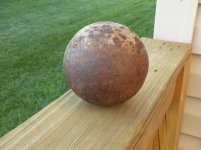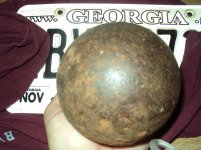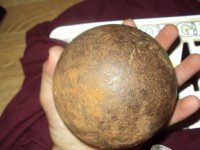tigerwitha88
Established Users
Just picked this up from a man that dug it out from under his porch about a year ago. It's approx. 5 inches in diameter and very heavy for its size, say around 15lbs at least. It has a core like a apple with two plugs on each side, one looks as old as the ball itself and the other looks like concrete maybe?
About 1/3 of it was exposed(the grey part) and the rest was underground. I thought the concrete looking matter on one end was likely from dewat but thinking of the mans story gives me the thought it may be live?
Any thoughts from those that may know what I have?
Thanks in advance.
About 1/3 of it was exposed(the grey part) and the rest was underground. I thought the concrete looking matter on one end was likely from dewat but thinking of the mans story gives me the thought it may be live?
Any thoughts from those that may know what I have?
Thanks in advance.









